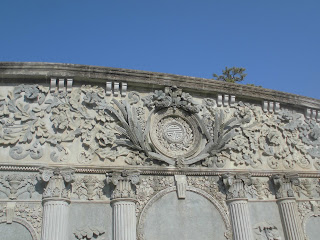位於台中市太平區有一個墳墓叫做「吳鸞旂墓園」。在我目前有看過墓園當中,是深信不疑最厲害的。墓園1922年由吳東碧建造。葬於他的父親吳鸞旂,還有幾位吳家的人。墓園是西洋式的。
您也不要再看我亂亂的中文文章,看下面的照片才對。
There is a truly incredible graveyard in Taichung, just to the south-east of the city center in the Tieping (太平) District. (Sorry, I couldn't find any English language information on it.) The graveyard is for Ooh Lwonchee (吳鸞旂), though it was constructed by his son, Ooh Doangbee (吳東碧), and it does have graves for other members of the family as well. The graveyard was constructed in 1922 a year after the elder Ooh had died. In 1992 it was designated as an important cultural property.
This is the most lavish, over-the-top grave I've seen in Taiwan. Ancestor worship is part of daily life in Taiwan, and many people do make regular contributions to the welfare of their deceased relatives, via burning joss paper etc. Related to that, taking good care of the graves of one's ancestors is also important, and people who have money will often spend a fair amount of it to make sure that a grave is nice to begin with. The Ooh family definitely had money.
台中にすごいお墓がある。お墓は1922年に呉鸞旂(ウールヮンチー)のために作られた。本人はその1年前亡くなったので、計画を立てたのは息子の呉東碧(ウードンビー)。台湾ではご先祖に冥銭などのお供え物をあげる習慣がかなり定着しているので、祖先を大事にする為に立派なお墓を建てることは珍しくない。でもここはやっぱりスケールが違う。1992年にこのお墓は文化資産として認められたぐらい建築がすごい。行けるなら行く価値がある。場所は台中市中心から少し離れた大平区だ。
我猜原本應該不是這樣,但現在墓園周邊是一個住宅區。其實是個封閉式社區。跟門口警備員請求就可以借到墓園的鑰匙。需要把身分證拿給他們,可是如果你不願意,也可以跳過墓園圍欄進去。沒有那麼高。我是借鑰匙進去的,但是我不認識你,也不知道你怎麼頑固。
This grave is in an odd location. Around it, a gated-community has been built. You have to drive through a road with a guard booth to get to where the grave is. If you ask at the guard booth, you can also get a key to open the gate to the grave. (The fence isn't that high, so if you're a rebel you can also just jump the fence.) Myself, I just asked for the key. In the photo below, which I took from inside the gate, you can see a bunch of the houses around the graveyard.
現在このお墓は住宅区の中に入っている。入り口の警備員にお願いしたらお墓への鍵を渡してもらえる。もしそれが嫌だったら(なんでそんなに嫌なの?)フェンスを飛び越えることが簡単にできるだろう。
A tile pattern on the outside of the gate.
如在紐約公園的地磚。真的很厲害西洋式的墓園。
Like many things built in 1920's Taiwan, there is a strong western influence on the grave's design. The tiles in this path look like they could be straight from one of the city parks in New York.
1920年代の台湾は建築が結構西洋の影響を受けた。地面を見たらニューヨークのセントラルパークにいる気分になった。というか、地面だけじゃなくて、周りのベンチなども19世紀から20世紀にかけての時代の西洋式の公園建築が取り入れられているような気がする。
家族はそれぞれ石碑がある。
家人在吳鸞旂兩邊。
灯篭もあった。
這面牆的裝飾也不錯!
Now let's look at the surrounding decorative wall. The design of the place is such that you enter through the gate and there is a flat area with hedges and the monuments to the family members. Behind all of that is this big wall, and behind that a large hill--possibly man-made.
石碑の周りにこの塀がある。後ろには地面が盛り上がっているが、おそらく人工かもしれない。
Really, so much of this looks like what you could see at some American city park that was designed in the late 19th to early 20th century. There are small touches here and there that betray that it's Taiwan, but the design is very western over all.
這是「吳」的字嗎?我不確定。
I think this is a stylized Chinese character, in which case it would probably be the family name, "Ooh". (吳)
これは多分漢字なのだろう。「呉」の字かな?
奉祀某神的石碑。
Off to one side is this small monument to a god with a space to burn incense in front.
入って右にはある神を祀っている石碑もある。
在牆後有小小的丘。
And we can walk up behind the wall on top of the hill from here.
ここから裏の盛っているところに登ることができる。
對面的丘有庶民的墳墓。
Behind the hill is another hill where all of the plebes are buried.
向こうには庶民どもの墓がある。
A trellis-y thing.
倒掉的石碑嗎?補石嗎?
These appear to extra stones, or maybe damaged stones that have been removed.
地震で倒れた石碑?余り物?
這個墓園會代表「寶馬香車」這個成語對不對?比我住的房子更厲害。
Now how's that for a grave? Better start saving your money now, huh?
すごかろう?これからお金貯めたら、死んだ時にはこんぐらい買えるかもしらんね!楽しみ!

















































死ぬ前に、とりあえず髪の毛切れよ。
ReplyDeleteはい、はい、、、
Delete